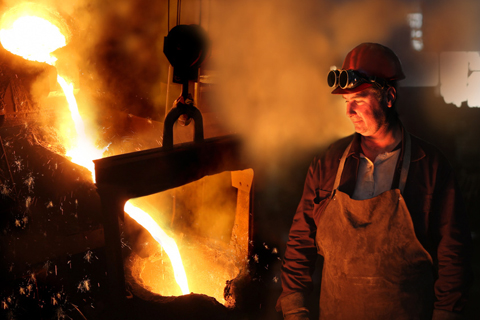RWI: German steel industry in the wake of industrial recession
by David Fleschen

The weak economy in German industry has reduced the total steel use in this country by almost 5 percent or around 1.8 million tonnes this year. In crude steel production, this is reflected in a decline of probably 5.6 percent. Next year, German rolling and crude steel production is likely to stagnate. This is what the RWI Leibniz Institute for Economic Research predicts in its current "Steel Report".
The most important results:
For Germany
The German steel industry has been caught in the past few months in the wake of the industrial license. The only reason for support was good construction activity. Consequently, crude steel production in Germany has declined significantly. It should sink this year on average by 5.6 percent.
- The average annual production of steel users in 2019 is expected to decrease by around 4 percent. This is likely to reduce the total steel usage by almost 5 percent or around 1.8 million tons.
- Nonetheless, the situation in the steel industry has recently stabilized somewhat following a marked decline in both crude and crude steel production in the first half of the year: inventories are now low, exports have picked up somewhat, and EU safeguard measures have led to a slowdown significant decline in imports from third countries. The latter had been introduced to protect the EU steel industry from massive trade diversions as a result of the US protectionist trade policy.
- The general economic conditions for the German steel industry are likely to remain unfavorable. The production of industrial steel users is likely to decline again next year, and construction investment will slow down. Steel usage is therefore likely to decrease by 2 percent on average for the year 2020. On the other hand, inventories should not be reduced as much as this year. All in all, German rolling and crude steel production is expected to stagnate in the coming year. Capacity utilization will thus remain at about the current low level of around 81 percent in the longer-term comparison.
- As the steel industry is likely to remain weak for another year, companies will adjust their employment. The RWI forecasts a decline of just under 2 percent or about 1,500 jobs.
- The German steel industry faces great risks in the short and long term. In the short term, Brexit and trade tensions in particular could put a strain on production because the associated high level of uncertainty among companies reduces the demand for experience in steel-intensive capital goods. Long-term risks are production relocations of their most important customers from Germany, in particular vehicle construction, which is realigning itself as part of the transition to e-mobility.
For the world:
- In the first eight months of this year, global crude steel output rose unexpectedly strongly at 4.4 percent over the previous year. However, this hides behind an increase in Chinese production by a good 9 percent. Overall, the rest of the world saw a slight decline, albeit with differences between regions.
- In the coming year, the development of global crude steel production will be shaped by China. It is expected to continue to increase, albeit slower. Since a further decline in crude steel production is to be expected for the other countries as a whole, steel production is expected to increase by just under 3 percent in the coming year, after a plus of just over 4 percent this year.
- Global capacity utilization is expected to rise slightly above the 81 percent achieved in 2018. This improvement is also largely due to China, while elsewhere the utilization rate is likely to fall. The problem of global overcapacity remains.
Commenting on the specific risks of the forecast, RWI Chief Economist Roland Döhrn says: "The impact of Brexit and trade tensions on the German steel industry in particular is difficult to predict. Their immediate consequences are manageable, but not the consequences of their associated uncertainty of the companies."
Source: RWI, Photo: Fotolia

